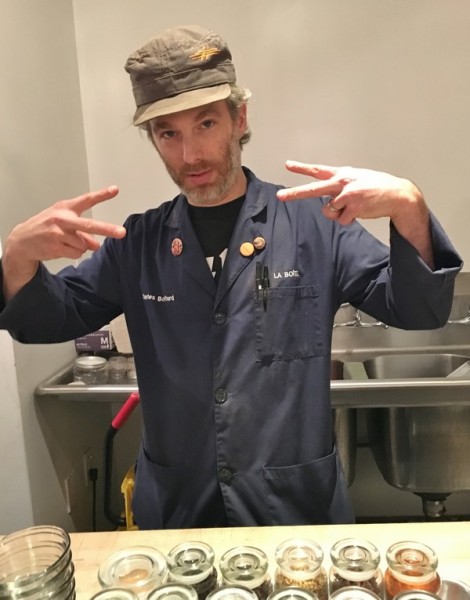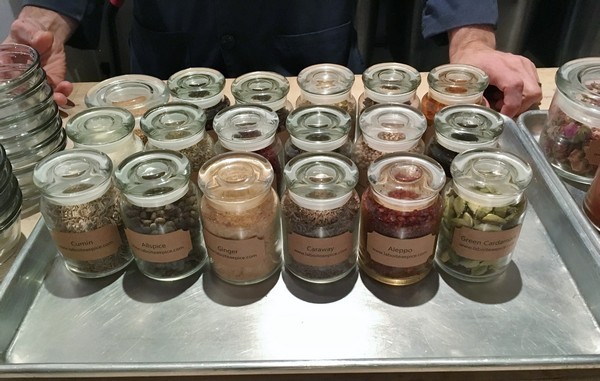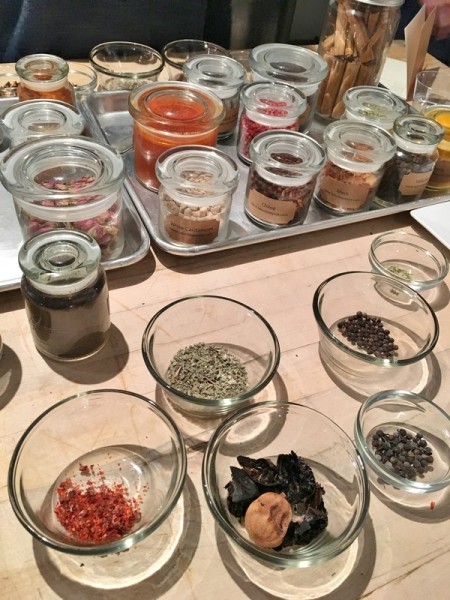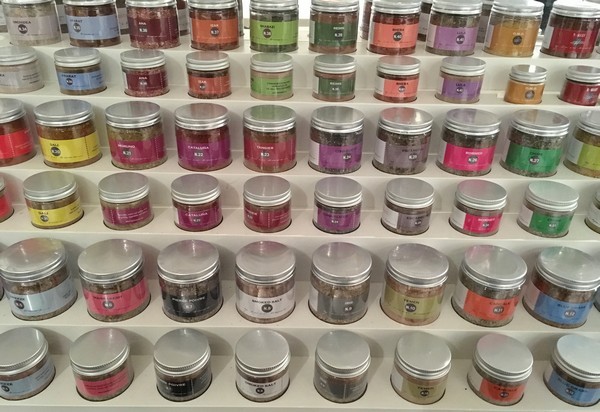 After about the first year of life, everyone knows what a spoon is used for, but confronted with a spice, we generally don’t have a clue. While you know what to do with salt, pepper, cinnamon and mint, what about allspice, cloves or mace? And while you can recognize a great tomato, would you know what cumin should taste like?
After about the first year of life, everyone knows what a spoon is used for, but confronted with a spice, we generally don’t have a clue. While you know what to do with salt, pepper, cinnamon and mint, what about allspice, cloves or mace? And while you can recognize a great tomato, would you know what cumin should taste like?
These observations and more were part of an interesting class the Accidental Locavore took recently at la Boîte. We were there to learn how to blend spices with Chef Lior Lev Sercarz. Initially you might think the whole thing is a little precious, but he’s got a down-to-earth attitude about his milieu, and a passion for finding the absolute best spices the world has to offer.
 Like a lot of other food products, the best spices have a season, and there are “vintages” or years when a crop will be far superior to others. While Lior gets his directly from farmers, for most of us it’s hit-or-miss since we have no way of knowing when something was harvested, how it was treated or even what its expiration date might be.
Like a lot of other food products, the best spices have a season, and there are “vintages” or years when a crop will be far superior to others. While Lior gets his directly from farmers, for most of us it’s hit-or-miss since we have no way of knowing when something was harvested, how it was treated or even what its expiration date might be.
When you buy them get them in small quantities and store in glass or plastic containers– you can see what’s in them and they don’t easily conduct heat. With wood or metal (which conducts heats too well), you can’t tell what’s inside. Avoid excessive heat and humidity, he says, and most spices can be refrigerated or frozen, but then, if you’re like me, you run the risk that you’ll forget all about them.
Lior suggests that you challenge yourself to use up a spice. Leave it out on the counter and try a bit of it in whatever you’re eating — from yogurt to yams. Worst case scenario, you have a bite of something and spit it out (French fries with a cinnamon spice blend), but you might decide that cumin in scrambled eggs is really delicious (it is)!
 When you’re trying to come up with a spice blend, or just figuring out what to do with single spices, he suggests that you keep the end-use in mind. For example, if you’re going to be grilling something, you don’t need to toast your spices, because the grill will do that. Otherwise, toasting helps to clean the spice and release any dormant flavors. While I used to toss spices in a small frying pan to toast, he suggests roasting them in a 350° oven for 5 minutes on a baking sheet with a second sheet nestled on top. It roasts them more evenly, and the second sheet keeps them from flying around — especially important if you’re using a convection oven as no one wants to be cleaning out stray caraway seeds!
When you’re trying to come up with a spice blend, or just figuring out what to do with single spices, he suggests that you keep the end-use in mind. For example, if you’re going to be grilling something, you don’t need to toast your spices, because the grill will do that. Otherwise, toasting helps to clean the spice and release any dormant flavors. While I used to toss spices in a small frying pan to toast, he suggests roasting them in a 350° oven for 5 minutes on a baking sheet with a second sheet nestled on top. It roasts them more evenly, and the second sheet keeps them from flying around — especially important if you’re using a convection oven as no one wants to be cleaning out stray caraway seeds!
 Currently there are over forty different blends in the store, with three additional special edition blends and collections. And my blend? I named it the “C” blend because it ended up with chiloe, cubeb, caraway, allspice, dried lemon and mace. If you don’t know what chiloe and cubeb are, neither did I, but it ended up being a warm blend, with a touch of heat and a bit of citrus. I tried it as part of a dry brine on some pork chops the other night and they were terrific (and I also remembered Lior’s other bit of advice — always add a little more of the spice to the finished product). It’s a small class, given once a month, so check on the website for available dates. Enjoy!
Currently there are over forty different blends in the store, with three additional special edition blends and collections. And my blend? I named it the “C” blend because it ended up with chiloe, cubeb, caraway, allspice, dried lemon and mace. If you don’t know what chiloe and cubeb are, neither did I, but it ended up being a warm blend, with a touch of heat and a bit of citrus. I tried it as part of a dry brine on some pork chops the other night and they were terrific (and I also remembered Lior’s other bit of advice — always add a little more of the spice to the finished product). It’s a small class, given once a month, so check on the website for available dates. Enjoy!